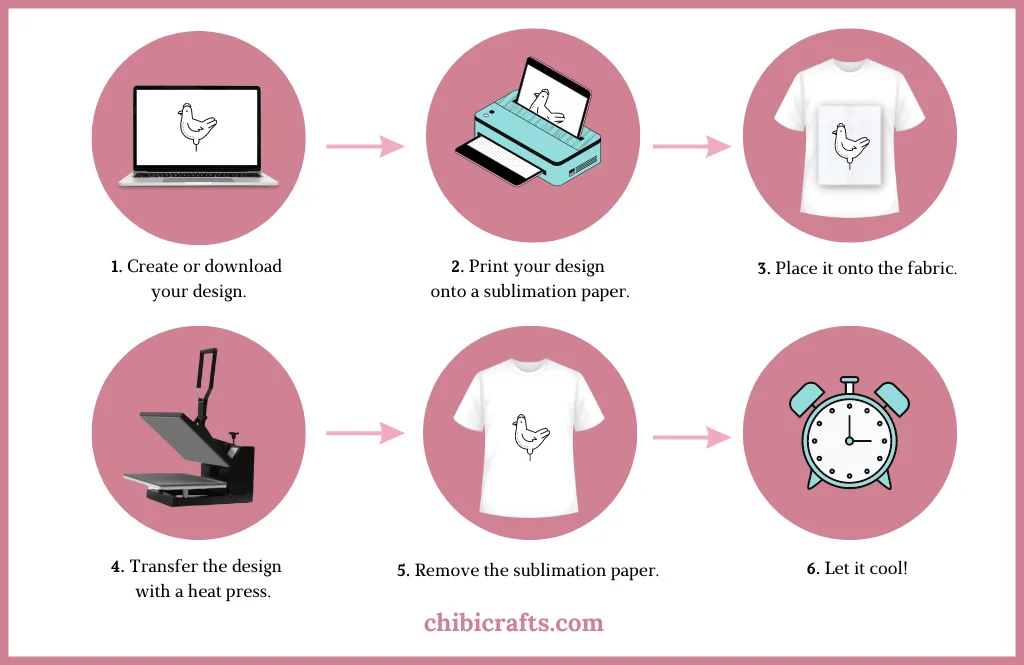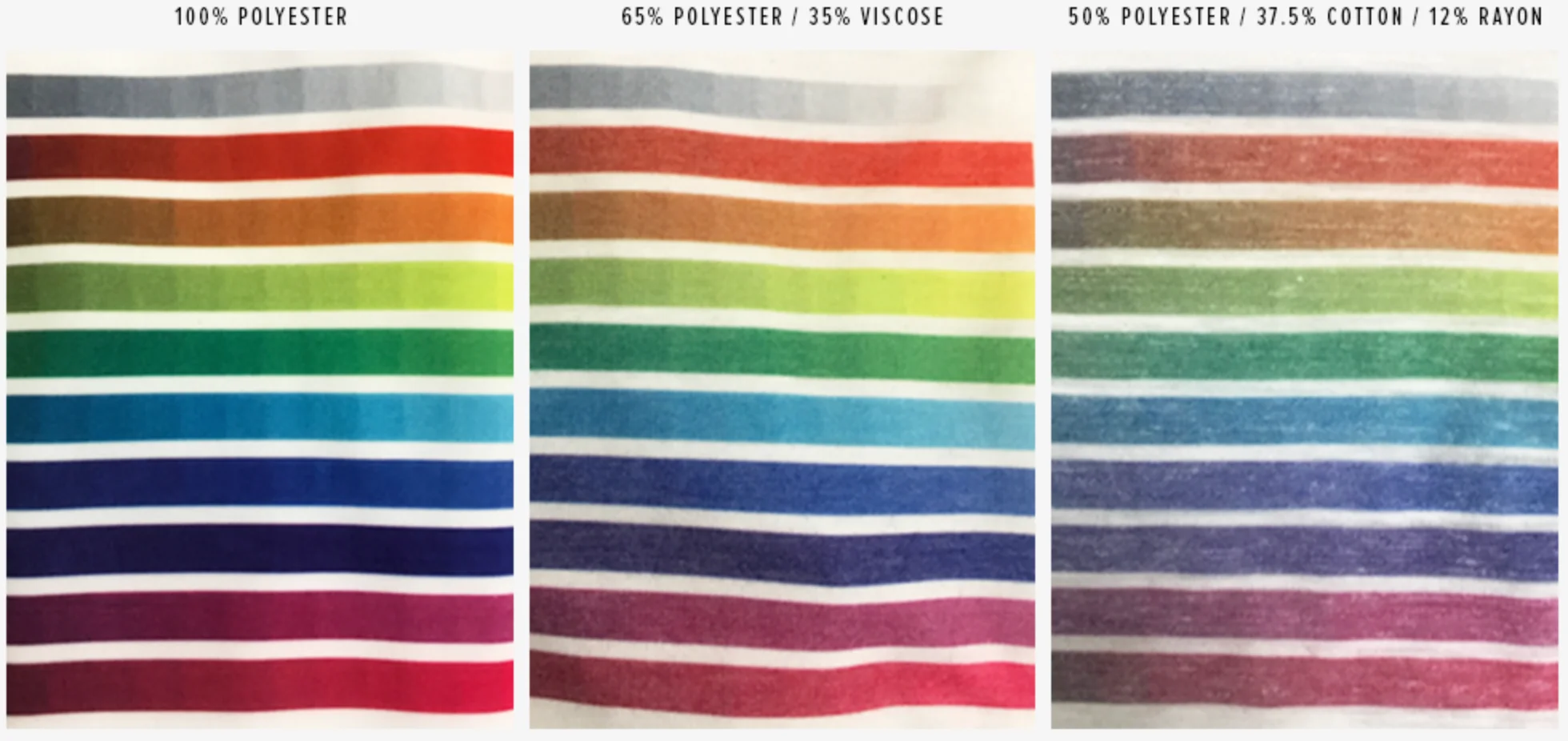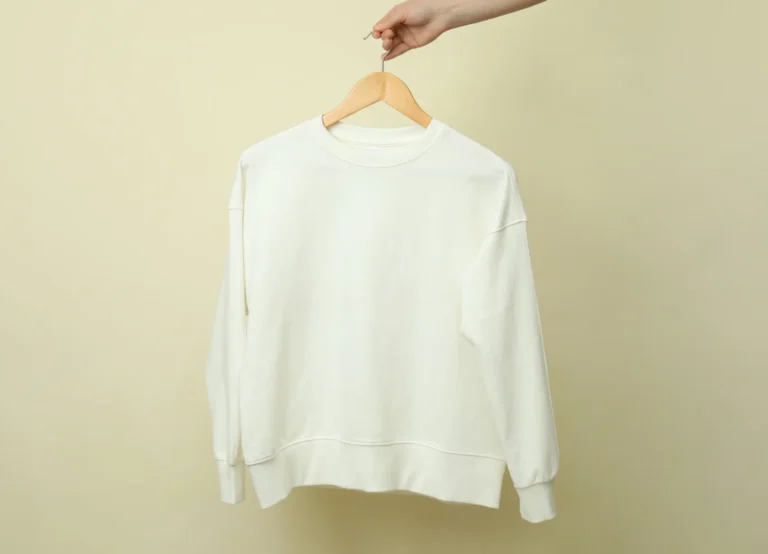Sublimation printing is an amazing technique that can bring your creative ideas to life by transferring designs onto different materials.
And guess what? You CAN sublimate on way more things than just 100% polyester!
In this guide, I’ll discuss what types of materials work best for sublimation printing so you can achieve the most vibrant, long-lasting results.
Read on to find out what you can (and can’t) sublimate on, and explore a detailed list of materials to help you choose the right one for your next project.
How Sublimation Works

Sublimation printing is a unique process where a special ink transforms directly from a solid to a gas, skipping the liquid state.
The ink deeply bonds with the material and makes the design a permanent part of the material. Unlike other printing methods, sublimation prints won’t peel, crack, or fade.
If you want to learn more, I explained everything you should know about sublimation printing in this ultimate guide for beginners.
What Materials You Can Sublimate On
Let’s start with the basics. Polyester is your preferred choice if you don’t want to spend time searching for rare materials (which we’ll discuss in a moment).
The golden rule is the more polyester, the better. A product made of 100% polyester will give you the most vibrant and long-living prints.

Blends can also work. For instance, a 65% polyester and 35% cotton fabric will accept the ink, but you should expect vintage and faded colors.
It’s not just about fabrics, though. Hard items like mugs or phone cases can have a special polyester coating that makes them suitable for sublimation.
So, if you’re printing standard design, simply look for items with high polyester content or a polyester coating.
Where to Get Sublimation Blanks
When I need new blanks, which is pretty much always, my first stop is usually Amazon. It sells everything on Earth, so it is no surprise it has thousands of sublimation blanks from apparel to funky phone cases. Plus, you can’t beat the convenience.
But sometimes, I love to head down to my local Dollar Tree. You’d be amazed at what you can find on a budget, and I get to touch the blanks before buying, which is a huge plus for me.
For those special projects that require top-notch quality, I order from niche crafting stores. It might be pricier, but you’re paying for premium material specifically designed for sublimation.
List of Materials You Can Sublimate On
After searching through forums, answering your questions, and reading some myths on Facebook groups, I put together this comprehensive table of materials that you can (or can’t) use for sublimation.
I hope that this list will save you a lot of time 🙂
Fabrics
Note that this table is about “pure materials.” For example, although cotton doesn’t work for sublimation, a blend of 75% polyester and 25% cotton produces good results.
| Material | Notes |
|---|---|
| Canvas | Polyester canvas is perfect for sublimation. Its texture can add a rustic feel to your designs, which some people really love. |
| Cotton | Cotton is a big no-no for sublimation. It doesn’t hold the ink well, so designs will fade after a few washes. Instead, choose blends with a small percentage of cotton or use HTV. |
| Rayon | While rayon can be sublimated, prints aren’t vibrant and may fade over time. |
| Leather | Traditional leather doesn’t do well with sublimation. It won’t absorb the ink, leading to faded and easily scratched designs. Faux leather or PU leather blanks are good alternatives. |
| Nylon | It’s a good option if you use low temperatures. However, there are many types of nylon, so the quality of your prints will be different. |
| Microfiber | Microfiber is usually made of polyester and nylon, so it’s a great choice for sublimation. |
| White HTV | This special heat transfer vinyl is designed for sublimation. It always provides consistent and bright results. |
| Fleece | Your prints will be vibrant and long-lasting, but only if it’s polyester fleece. |
| Modal Fabric | You can sublimate on modal fabrics if you pre-treat it with a coating. |
| Burlap | You can sublimate on faux burlap and burlap with a polyester coating. |
| Satin | Only if it’s 100% polyester. |
| Neoprene | If the outer layer is made of polyester, it works really well for sublimation. Your prints will be vivid and long-lasting. |
| Spandex | You can sublimate on poly/spandex blends. The higher the percentage of spandex, the more fabric shrinks. |
| Felt | Felt is typically made out of polyester, so it’s perfect for sublimation. Real wool felt won’t work. |
| Velvet | Not recommended if it’s natural velvet. 100% polyester velvet works perfectly. |
| Viscose | You cannot sublimate on 100% viscose as it’s made of cellulosic fibers, like cotton. |
| Polypropylene | It’s possible to sublimate on non-woven polypropylene. |
| Faux Fur | Nope, avoid this one. |
| Linen | Linen requires pre-treatment similar to the one used for cotton. |
| Polyamide | 100% polyamide produces bad-quality prints that fade quickly. |
| Sherpa | It’s a good choice if you’re using polyester-based sherpa. |
| Silk | Despite its luxurious feel, silk is a poor candidate for sublimation. Your prints will look faded and will wash out with time. |
Hard Substrates
Quick tip: You can sublimate on most of the hard substrates. Apply sublimation-ready coating, and you’re good to go!
| Material | Notes |
|---|---|
| Wood | You can sublimate on bare wood, but prints may be faded. Pre-treating with a sanding sealer or polycrylic gives more vibrant results. |
| Acrylic | Acrylic is tricky. It tends to melt if you use the wrong settings. If you can get the settings right, prints on acrylic look great. |
| Glass | A total winner if you’ve got it coated. The results are usually eye-poppingly vibrant. |
| Stainless Steel | Stainless steel with a polyester coating is your best buddy. Colors come out vivid and stick around. |
| Ceramic | Ceramics is perfect for sublimation, especially ceramic mugs. Just make sure your blank is coated. |
| Chipboard | Works if you give it a nice coating first. |
| Metal | Coated metal is a playground for vivid and durable designs. So go wild! |
| Painted Wood | Painted wood is a bit of a wild card. You can get good results after applying a polyacrylic coating after the paint. |
| Aluminum | Sublimation blanks with pre-treated aluminum can produce stunning results. |
| Bamboo | Bamboo’s not the usual material, but everything is possible with a polyester coating. |
| Epoxy Resin | No, you can’t sublimate on epoxy resin. |
| Marble | Coated marble does alright, but the ink might crack a bit over time. |
| Plywood | Plywood’s cool as long as it’s used with lamination film. But the texture could mess with your design clarity. |
| MDF | MDF is pretty chill with sublimation – coat it, and you’re good to go. |
| Slate | You can sublimate on the slate as long as it has proper coating. |
Specialty Items
| Material | Notes |
|---|---|
| Mirrors | Sorry, no selfies with sublimated mirrors. The ink just doesn’t bond. |
| Balloons | Definitely not. Unless you want a ‘pop’ in your process! |
| Candles | Nope, unless you want a hot mess. |
| Chalk Paint | Incompatible — like trying to mix oil and water. |
| Coir | It’s possible, but your prints won’t be vivid. |
| Cork | You can sublimate on cork if you apply a polyester coating or buy pre-made sublimation blanks. |
| Enamel | Only if these items have sublimation-ready coating. |
| Flannel | It’ll work but don’t expect colors to dance off the fabric. |
| Jute | The texture isn’t ink-friendly. Skip this one, or use a polyester coating. |
| Melamine | Yes, if you pre-treat it with a coating. Remember that products with prints must be decorative only. It’s unsafe to eat from coated melamine plates. |
| Muslin | Will result in faded prints, so maybe skip this one. |
| PVC | Use lamination films and be careful with fumes. |
| Sticker Paper | Absolutely, but only go for the types designed for sublimation, not the standard sticker paper. |
| Plastic | Generally, a no. Some types of plastic can be sublimated if they’re flat and reinforced with fiberglass. |
Conclusion
We’ve made it — the most comprehensive, no-nonsense guide on what you can and can’t sublimate on.
Remember that not all surfaces are created equal. Always test your materials and check the labels or guidelines when in doubt.
Knowing your materials is half of the battle. So, what are you waiting for? Go forth and create!



